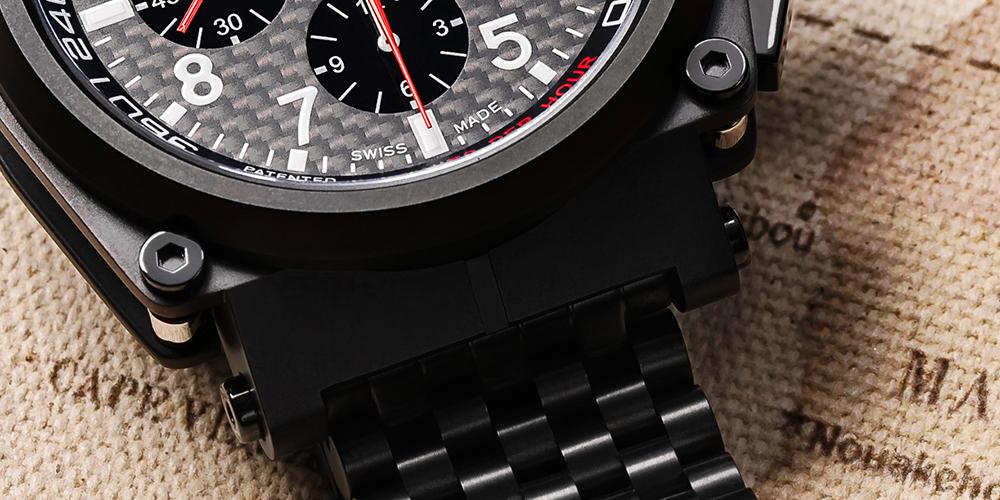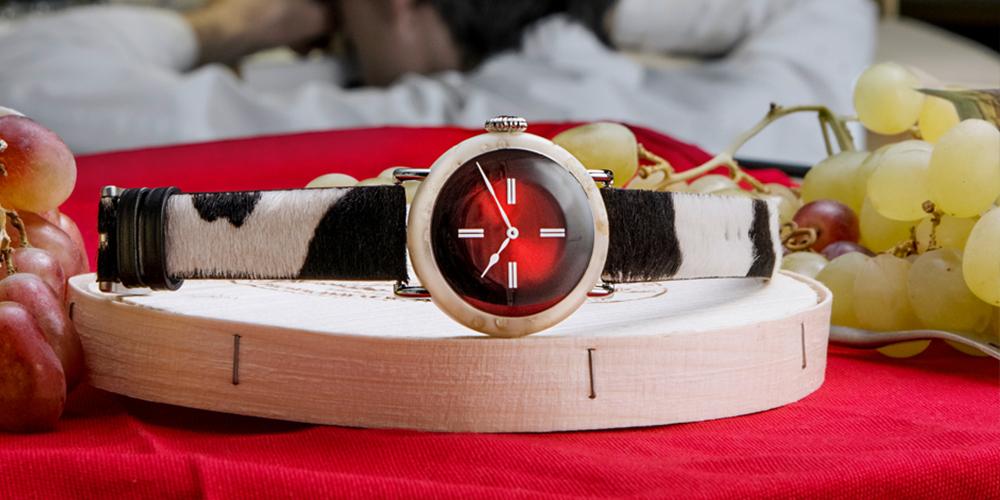[8min reading time]
Hard and light, scratch-resistant and unbreakable: When it comes to the watch case, demands are plentiful and just as diverse as the materials from which the cases are built. Until the 1970s, brass with a layer of chrome or gold was the material of choice, while luxury watches were made entirely of gold.
Today, the considerably harder, but also more difficult to process stainless steel is the go-to material in case manufacturing. It meets the high demands on surface homogeneity, robustness and durability. Nowadays however, a variety of other materials are routinely being worked to create cases and other watch components, some of which are ceramics, carbon fiber or bronze.
When Stainless Steel turned Luxurious
Audemars Piguet and Patek Philippe were the first manufacturers to make the use of steel in the luxury sector socially acceptable when they released the Royal Oak and the Nautilus. Cases and bracelets today are usually made of an alloy containing steel, chrome, nickel and molybdenum, which is called 316L. One of its main advantages is the high resistance to corrosion and relative toughness. While most brands mainly use different variations of 316L Steel, Rolex cooks up their proprietary 904L alloy, which is more corrosion resistant to acids, but is similar to 316L in hardness and thus scratch-resistance.

The base material of stainless steel is ordinary iron ore or recycled steel. In order to refine it, the carbon content must be reduced and impurities such as phosphorus, sulfur, silicon, oxygen, and manganese must be eliminated from the alloy. To this end, the iron ore is smelted in a blast furnace and supplemented with coke and limestone, both of which bind the aforementioned impurities, which then either escape in gaseous form or collect into pool of slag that floats on top of the molten iron and can be drained. The temperature at the bottom of the furnace reaches well over 1’650 °Celsius (over 3’000 °Fahrenheit). In total, there are more than 200 types of stainless steel, which are alloyed depending on the intended use.

Stainless steel forms a very good basis for being esthetically modified: In some cases, cases and bracelets are coated with carbon in a so-called DLC (Diamond-Like Carbon) or PVD (Physical Vapor Deposition) process. These treatments can change the color and the physical properties of the top layer of the base material, which can increase the scratch-resistance.
Titanium: lighter than steel, but not hard
Porsche Design and IWC were the trailblazers when it comes to titanium, a metal that also emerged in watchmaking in the 1980s. Titanium is light - about half as heavy as steel - tough, non-magnetic, corrosion-resistant and anti-allergic. The most commonly used watch case titanium alloy is Grade 5, an alloy of 6 percent aluminum and 4 percent vanadium. Titanium is tough, but not hard: scratches quickly form, which are very noticeable at first. The natural oxidation, however, changes the color again and makes the scratch almost invisible after a while.

Ceramic: hard and scratch resistant
Ceramics go one step further: a rich deep shine, incredible scratch-resistance, and a light, comfortable wrist presence characterize the material. Hallmark of Rado, the first brand to produce watches made of this avant-garde material in large quantities, high-tech ceramics made their first watch-related appearance in the 1980s after one of the first applications was in the heat shield of the Spaceshuttle. The starting material for high-tech ceramics is ultrafine zirconia or titanium carbide powder with a particle size of about one-thousandth of a millimeter or one-fifth of the thickness of a human hair. This powder is pressed into shape with a steel mold and then sintered. One critical aspect to be mastered by the manufacturer is the considerable shrinkage the component experiences during sintering. Depending on the thickness of the workpiece, it can shrink in size by up to 20 percent. This has to be taken into consideration when engineering the steel molds in order to be able to keep to the micro-tolerances customary in watch case production. In addition, ceramics are expensive to work with due to the high wear of machining tools during further processing and the abrasive diamond paste used for the finishing touches. As a rule of thumb, something around 30 percent surplus components must be produced to make up for the subsequent “weeding out” of esthetically defective pieces during intermediary or final quality control. This is the only way to meet the extremely strict visual and functional quality demands of luxury watch brands.

At a temperature of almost 1’500 °Celsius (about 2’700 °Fahrenheit), the material is sintered into scratch-resistant ceramic parts. The color can be influenced by adding high-purity, harmless color oxides when mixing the material. Nowadays, manufacturers are using state-of-the-art Ceramic Injection Molding (CIM): In this process, the ceramic powder is homogenized, turned into granulate, processed by injection molding, sintered and then machined. Using different materials to create a case can be very elegant: a basic stainless steel case with a ceramic bezel not only looks beautiful but also effectively protects the particularly exposed bezel from scratches.
Carbon fiber: ultra-light and almost unbreakable
Carbon fiber is enjoying increasing popularity in the watch world. It is light, scratch-resistant and has an interesting structure that is immediately recognizable as carbon, making each watch unique. However, the processing is complex. Carbon is made from synthetic resin threads with a small diameter. Tiny carbon fibers with a diameter of just seven-thousandths of a millimeter are incorporated into the resin. Carbon fibers weight less than 2.6 grams per cubic centimeter - extremely light, but extremely resilient due to the orientation and coherence of the grain in the final product.
Robust and lightweight, carbon fiber is a material that unites the best properties found in metals and ceramic: It is almost unbreakable, quite scratch-resistant, not prone to corrosion and hardly knows any limitations in everyday life. Even allergic people won’t encounter any problems while wearing a watch made out of this spectacular material.
Raphael Granito, CEO Formex Watch SA
In practice, a carbon fiber case is 50 percent lighter than one made of titanium! Fiber-reinforced plastics are thus becoming a key technology for lightweight construction and in some cases to complete assembly modules of aircraft or vehicles are made of this material. The processing of carbon fibers, however, poses substantial challenges, and the processes conceived in the aeronautical industry cannot be transferred 1:1 into the watch industry. The difficulties include almost catastrophic tool wear and high rejection rate during production.

One of the common ways of shaping carbon fiber for watches parts is to “forge” them: Carbon fibers are heated to high temperatures and pressed into stainless steel molds with up to 300 kg per square centimeter: it’s basically an oven with very high pressure. What's left when the pressure is released is pure carbon fiber. In this process each piece is aesthetically unique, because the individual fibers don’t set in a particular order during baking.
Bronze: the „old“ look
The last few years saw the rise of a new trend in watchmaking, which is everything but indifferent to outside influences. We are talking about the mixture of copper and tin, the first man-made alloy. It boasts excellent resistance to salt water, which is why it has been used in marine-related engineering from the early days. Bronze is also antimagnetic, low-wear, elastic, but little more brittle compared to its ferrous sibling, stainless steel. The specific weight is about ten percent higher than that of steel.

A particularly sought-after characteristic among watch nerds, is the way bronze reacts with oxygen. It forms a layer of oxidized copper, which looks very "old", but actually protects the material below. The watches turn into a unique object that to some tells a tale of the time passed on the wearer’s wrist. However not every watch fan likes the aged look of a patina, which can be removed, albeit with the help of some chemical agents.
Say cheese
Moser & Cie., a Swiss manufacturer of high-end timepieces - has taken the material game to the extreme: The case of the "Swiss Mad Watch" is made of genuine Swiss cheese, a Vacherin Mont d'Or médaille d'Or. A binding agent ensures that the cheese neither stinks nor melts in the heat but remains rock hard and thus stable. Nevertheless, the model has no future: only one piece was made.

What’s my favorite material?
With so many options to choose from, one question arises: Which material best suits you? First and foremost, that is a matter of taste - bronze with a green patina is not for everyone, and weight may be a critical element for some watch aficionados. Many of us, when wearing a high-quality watch, like to feel some substance and heft, to be reminded of the substance of what we are wearing. For this and many other reasons, stainless steel will probably remain an eternal classic - a material that can be brought alive by the skillfully achieved interplay of matte, brushed and polished surfaces. It can be repaired in the event of damage, and is very robust in everyday life. Carbon, on the other hand, is something special: The lightness of an ultramodern timepiece with a mechanical movement certainly creates fascination and tends to be more than a conversation starter for any type of engineering, aeronautics, sailing or racing enthusiast
When taking a look at my own collection of watches, stainless steel dominates. But watches made of carbon fiber, titanium and even aluminum are also represented, with even a few rare pieces in gold making an appearance on even rarer occasions. The bronze watch had to go: it was beautiful when new but I rather quickly found out that patina doesn’t really work for me. I’ve always been a fan of the masterful combination of materials. A watch with a ceramic bezel on a steel case for instance, evokes in me a feeling of symbiosis.




















































